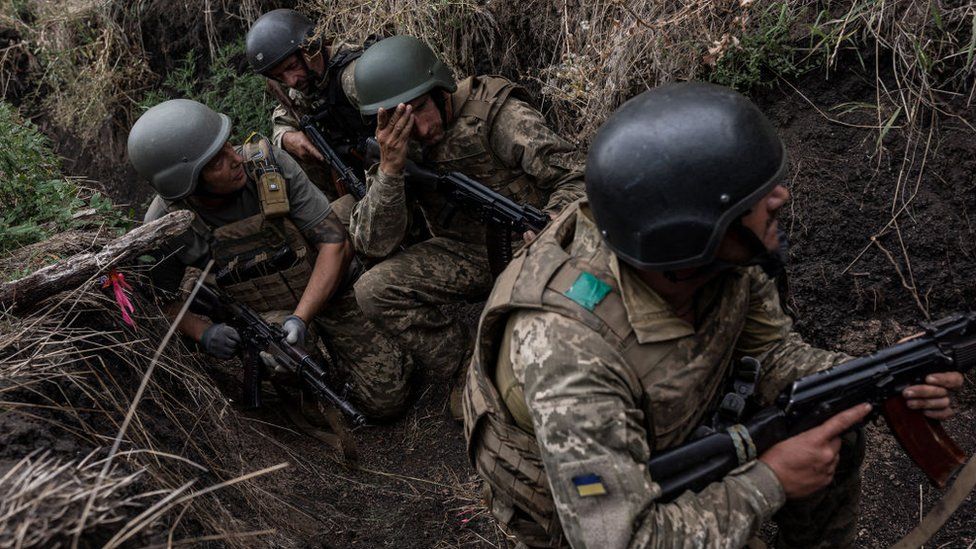-

-
-
Loading

Loading

Ukraine's military leaders claim that they have made a breakthrough in Russia's first line of defense in the southern region. To assess the actual progress of Ukrainian forces and identify signs of further advancements along the frontline, we need to examine the situation more closely. In early June, Ukraine initiated a major counter-offensive to regain control of the land seized by Russian forces. The offensive was launched simultaneously at three points along the 600-mile-plus frontline. The area to the southeast of Zaporizhzhia, in particular, holds significant strategic importance. A successful strike in this direction, towards the Sea of Azov, could potentially cut off Russia's supply lines connecting Rostov-on-Don to Crimea. Thus far, progress in this area has been limited, with the exception of the villages of Robotyne and Verbove in the Zaporizhzhia region, as highlighted in the map provided. If Ukraine manages to sever this major supply route, it will severely impact Russia's ability to maintain its substantial garrison in Crimea, which it annexed in 2014. Despite significant obstacles, there have been confirmed sightings of Ukrainian troops breaching Russia's defensive structures along the southern front. Nine social media videos along the frontline near Verbove have been verified, with four of them showing Ukrainian forces successfully infiltrating Russian defenses to the north. However, these incursions do not necessarily indicate that Ukraine has gained control over the area. Only Ukrainian infantry have been able to get through so far, and there is no evidence of armored columns pouring through to exploit and hold the captured territory. Moscow anticipated this counter-attack well in advance and has spent months constructing layered defenses consisting of obstacles, trenches, bunkers, minefields, and artillery. These formidable defensive structures can be seen from space. Vast minefields have slowed down the Ukrainian advance, with mine density reaching up to five mines per square meter in some places. Ukraine's initial attempt to charge through the minefields in June was unsuccessful, resulting in significant damage to their modern, Western-supplied armor and heavy casualties among infantry. Subsequently, Ukraine has resorted to clearing the mines on foot, often under fire and at night, further impeding progress. Ukraine's tanks and armored vehicles remain vulnerable to Russian mines, drones, and anti-tank missiles. Their ability to advance in significant numbers depends on clearing wider paths through the minefields and suppressing Russian artillery positions. According to Dr. Marina Miron from King's College London War Studies Department, the challenge for Ukraine now is to create a large enough opening to bring in additional troops. Meanwhile, Russia has been reinforcing its forces, and the battlefront remains dynamic, offering the potential for Russia to reverse Ukraine's gains. Evidence suggests that Russian airborne forces, known as the VDV, have deployed near the town of Verbove to fill any gaps created by Ukraine's counter-offensive. Ukrainian forces continue to encounter resistance from Russian forces on the battlefield, in addition to artillery fire, drone attacks, and extensive electronic warfare measures aiming to disrupt Ukrainian signals and drone usage. Currently, Ukraine has advanced less than 10% of the way to the coast. However, the situation is more complex than a simple measurement of progress. Russia's forces may be exhausted and demoralized after enduring three months of intense attacks, including targeted strikes on their supply lines. If Ukraine can successfully breach the remaining Russian defenses and reach the town of Tokmak, Russia's rail and road supply routes to Crimea would be within range of Ukrainian artillery. Such an achievement would qualify as a significant success for this counter-offensive. While it may not bring an end to the war, which is likely to continue well into 2024 and beyond, it would greatly undermine Moscow's war effort and position Ukraine strongly for future peace talks. However, time is running short for Kyiv. The rainy season will arrive within weeks, rendering the roads muddy and hindering further advances. Additionally, the outcome of the upcoming US presidential elections adds further uncertainty. If a Republican victory occurs, military support for Ukraine from the US could be dramatically reduced. President Putin understands that he needs to weather the storm until then, while Ukraine is aware of the importance of achieving success with this counter-offensive. The reporting for this article was done by Jake Horton, Paul Brown, Benedict Garman, Daniele Palumbo, and Olga Robinson. Graphics were provided by Tural Ahmedzade, Mark Bryson, and Erwan Rivault.